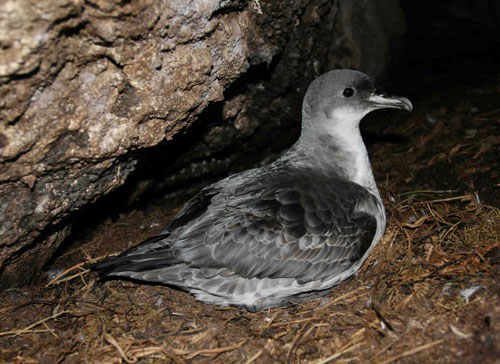
Grey Petrel, photograph by Peter Ryan
Kalinka Rexer-Huber and Graham Parker (Parker Conservation, Dunedin, New Zealand) have reported this month to the Conservation Service Programme of New Zealand’s Department of Conservation on how best to estimate Grey Petrel Procellaria cinerea numbers on Antipodes Island.
The draft report’s summary follows
“Antipodes Island is thought to have by far the largest population globally of grey petrels Procellaria cinerea, but the trend in population size over time remains unknown. This work focuses on planning an updated estimate of population size and trend. We collate and assess resources from previous work, using these to develop recommendations for field work that will yield a robust population estimate.
Our focus here is the methods and findings of grey petrel studies on Antipodes in the early and late 2000s: the feasibility study in 2001 (Bell 2002) and population research in 2009–10 (Thompson 2019). A valuable record of observations underpinned those studies, so key observations on grey petrel behaviour and occurrence over trips since 1969 were extracted from notebooks by Bell and Burgin (Appendix A).
We first collated resources, then compared and contrasted methods and findings from previous work (section Assess existing information). Requirements for a robust, repeatable population size estimate and best-practise approaches are discussed in Design a robust population estimate. Taken together, previous work and requirements inform a range of options for population size estimation, with key pros and cons noted for each field strategy (Ranked methodologies).
Balancing effort, flexibility and precision of the population size estimate, the recommended field strategy is spatial coverage distance sampling. This approach uses distance sampling following a simple-random design that maximises spatial coverage. Several other good options suggest variations but with key things in common: timing (occupancy sampling should occur in second half April), accounting for habitat lost to landslips, and using true surface areas of grey petrel habitat in calculations. With broad sampling across the grey petrel range, an accurate, robust, repeatable population size estimate can be produced.”
Reference:
Rexer-Huber, K. & Parker, G. 2020. Antipodes Island grey petrels: assess and develop population estimate methodology. DRAFT Final report to Department of Conservation, Conservation Services Programme for project POP2020-04: Grey petrel population estimate methodology, Antipodes Island. Dunedin: Parker Conservation. 35 pp.
John Cooper, ACAP Information Officer, 23 December 2020

 Español
Español  English
English  Français
Français